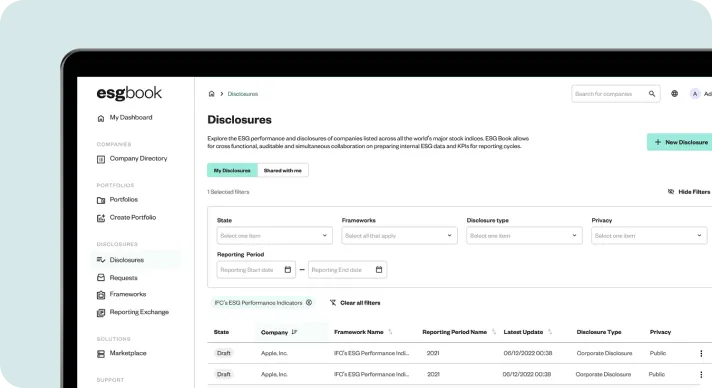Consultation Response by ESG Book GmBH to the Amended ESRS Exposure Drafts

ESG Book welcomes the opportunity to provide feedback on the amended European Sustainability Reporting Standards (ESRS). We recognize EFRAG’s efforts to streamline reporting obligations while maintaining transparency and usability of sustainability information. The amendments represent an important step toward balancing proportionality for preparers with the need for robust, decision-useful data to advance the EU Green Deal objectives.
Our overarching position: simplification must not dilute the robustness or comparability of disclosures. The six simplification levers are well-targeted, but careful implementation and safeguards are needed to ensure proportionality, transparency, and interoperability.
We have structured our response around the six simplification levers identified in the Exposure Drafts.
1. Clarify Sustainability Statements
We support the reinforced role of ESRS as a fair presentation framework, which reduces checklist-style compliance and encourages principle-based reporting. The flexibility to use executive summaries and appendices enhances readability and improves connectivity between financial and sustainability statements. To safeguard against misuse, clear guidance is needed to ensure summaries remain accurate and not selectively incomplete. Overall, this lever successfully clarifies presentation without undermining ambition.
Our recommendation: Further examples of “connected information” would help preparers avoid fragmentation, while assurance providers should be guided to assess proportionality rather than volume of disclosures.
2. Simplify Double Materiality Assessment (DMA)
We welcome the simplification of DMA, particularly the ability to apply top-down or bottom-up approaches and the explicit recognition of information materiality as a general filter. This allows undertakings to align DMA with existing risk management processes and avoid unnecessary documentation. Guidance on aggregation/disaggregation by sector, geography, and risk density enhances proportionality and decision-usefulness.
However, new guidance on remediation, mitigation, and prevention actions introduces interpretive complexity. Assessing potential impacts on a “gross” basis may penalize companies with proactive risk management. This risks reducing comparability and distorting risk profiles.
Our recommendation: Maintain the flexibility of qualitative disclosure on remediation while ensuring comparability across companies. Reliefs should be accompanied by clear disclosure of methodologies, assumptions, and judgments.
3. Improve Standards Clarity
We strongly support the restructured ESRS architecture, which clearly separates mandatory from non-mandatory provisions and eliminates “may disclose” datapoints. The re-labelling of MDRs as GDRs, streamlining of PAT requirements, and consolidation of duplicative disclosures substantially reduce complexity. Centralizing human rights policies in ESRS 2 GDR-P and merging overlapping disclosure requirements across social standards further enhances usability.
Our concern is that a more principles-based PAT framework may risk reduced granularity, especially if disclosures are too high-level. Without topic-specific detail, alignment with SFDR Principal Adverse Impact (PAI) indicators may weaken.
Our recommendation: Retain flexibility, but ensure PAT disclosures remain sufficiently linked to material IROs, particularly emissions, social violations, and governance breaches.
4. Enhance Interoperability
We welcome the strengthened alignment with the ISSB’s IFRS S1 and S2 standards, particularly the adoption of the financial consolidation boundary for GHG emissions and the recognition of operational control for complex structures. Reliefs aligned with IFRS (undue cost/effort, quantitative ranges) improve usability while maintaining transparency.
However, some reliefs extend beyond IFRS provisions (e.g., permanent data quality reliefs), creating new interoperability differences. The deletion of certain IFRS-aligned datapoints (e.g., gross GHG intensity, remuneration linkages) may also reduce comparability.
Our recommendation: Retain IFRS-aligned datapoints in Non-Mandatory Illustrative Guidance (NMIG) or Application Requirements to preserve comparability. Regulators should continue joint alignment efforts to avoid divergence and dual reporting costs.
5. Reframe MDR–Topical Specification Connection
Simplification of the connection between ESRS 2 and topical standards reduces duplication and improves consistency. Minimum Disclosure Requirements (renamed General Disclosure Requirements) remain mandatory, while redundant topical specifications have been deleted. Connectivity between PAT disclosures and IROs has been improved, enabling reporting at higher aggregation levels when appropriate.
While this enhances clarity, we caution that removal of detailed requirements risks diluting comparability across undertakings. Eliminating mandatory disclosure of PAT plans and timelines could obscure sustainability risk management horizons.
Our recommendation: Retain mandatory disclosure of timelines or phased implementation for key material IROs. This would ensure short-, medium-, and long-term risks are visible to stakeholders.
6. Relief Burdens
We broadly agree with the introduction of proportionality reliefs, including “undue cost or effort,” partial-scope metrics, and pragmatic treatment of acquisitions/disposals. These adjustments enhance feasibility for preparers, particularly first-time reporters, while maintaining transparency. Additionally, we support requiring both qualitative and quantitative disclosures of anticipated financial effects, with relief available under conditions of high uncertainty or when no reasonable quantitative information exists. This approach ensures that quantitative information remains central for investors, maintains comparability and interoperability with IFRS S1/S2, and provides flexibility to address feasibility, data limitations, or commercial sensitivity without weakening transparency. Limiting reporting to qualitative disclosures only would reduce decision-usefulness and increase dual-reporting costs.
Permanent reliefs for poor data quality risk removing incentives to improve data coverage and may undermine the integrity of the CSRD framework. Reliefs must therefore be proportionate, time-bound, and clearly disclosed. We also oppose the proposed exemption for financial institutions to report absolute GHG reduction targets only when setting intensity-based targets, as absolute emissions remain critical for assessing financed emissions and transition alignment.
Our recommendation: Link reliefs to phased assurance timelines and require disclosure of improvement plans when partial-scope, estimated, or relief-applied data is used. Absolute emissions disclosures must remain mandatory for financial institutions, even when intensity targets are set, to ensure transparency on progress toward the EU’s climate objectives.
Conclusion
The amended ESRS represent meaningful progress in simplifying sustainability reporting while preserving ambition. ESG Book supports the six simplification levers, provided that safeguards ensure robust, comparable, and interoperable disclosures. We urge EFRAG and the European Commission to:
- Maintain the fair presentation principle as the foundation of ESRS.
- Ensure DMA flexibility is balanced with clarity on remediation/mitigation impacts.
- Preserve topic-level granularity where material, especially for SFDR alignment.
- Avoid divergence from ISSB standards by limiting reliefs beyond IFRS S1/S2.
- Require timelines or improvement plans alongside reliefs to safeguard comparability.
- Retain absolute GHG reduction targets as a mandatory disclosure for financial institutions.
With these refinements, the revised ESRS can provide a practical yet rigorous framework that supports decision-useful disclosures, strengthens the EU sustainable finance agenda, and enhances global interoperability.
Visit esgbook.com for more information.



